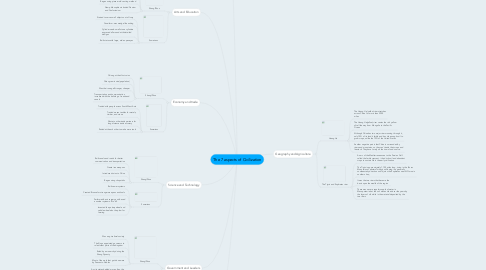
1. Geography and Agriculture
1.1. Huang He
1.1.1. The Huang He (yellow) river stretches across China for more than 2900 miles
1.1.2. The Huang He(yellow) river carries the rich yellow silt all the way from Mongolia to the Pacific Ocean
1.1.3. Although China has two major rivers running through it, only 10% of its land it fertile and has rich enough soil to grow crops, unlike the 19% of the United States
1.1.4. Another negative part is that China is surrounded by rivers and mountains, so they can't trade their crops and livestock. They have to rely on their own food source.
1.2. The Tigris and Euphrates river
1.2.1. An arc of the Mediterranean sea to the Persian Gulf called the fertile crescent. it had rich soil and abundant crops to sustain life in the early civilization
1.2.2. The Tigris is approximately 1,150 miles long, rising in the Taurus Mountains of eastern Turkey and flowing in a generally southeasterly direction until it joins the Euphrates near Al Qurna in southern Iraq
1.2.3. It was the two rivers that became the basis upon the wealth of the region
1.2.4. There was never a regular supple of water in Mesopotamia but the soil was enriched over the years by the layers of silt which is the material deposited by the two rivers
2. Social Structure and Family
2.1. Shang/Zhou
2.1.1. King, Nobles, Peasants, and Aristocrats
2.1.2. The Emperor was in charge of everyone
2.1.3. The Peasants took orders from nobles and lords
2.1.4. The King eventually lost power to the Aristocrats overtime
2.2. Sumerians
2.2.1. Men was in charge of the political power an made the laws
2.2.2. The Women took care of the children while also doing chores around the house
2.2.3. Lowest to Highest class order: Slaves, Laborers, Farmers, Artisans, Wealthy Merchants, Big land owners, Priests and Kings
2.2.4. Some upper class women were classified to be Priestesses
3. Government and Leaders
3.1. Shang/Zhou
3.1.1. Was a agricultural society
3.1.2. The Kings appointed governors to rule distant parts of the kingdom
3.1.3. Ruled by a monarchy during the Shang Dynasty
3.1.4. Most of the work that got done were by Peasants- Nobles
3.2. Sumerians
3.2.1. As city states battled more often, the war chiefs began to rule as Kings
3.2.2. The Sumerians were a Priest governed city states
3.2.3. Kings formed dynasties by a series of rulers from one family
3.2.4. The Sumerian Kings served as god chief representatives and performed city wide ceremonies to please them
4. Science and Technology
4.1. Shang/Zhou
4.1.1. Built canals and roads for better communication and transportation
4.1.2. Create iron weapons
4.1.3. Introduced coins to China
4.1.4. Began using chopsticks
4.2. Sumerians
4.2.1. Built sewer systems
4.2.2. Created Bronze for stronger weapons and tools
4.2.3. Performed basic surgery and based a number system off to 60
4.2.4. Invented the pottery wheel and vehicle wheel also the plow for farming
5. Economy and trade
5.1. Shang/Zhou
5.1.1. China got their first coins
5.1.2. Cities grew in size(population)
5.1.3. Was the iron age-Stronger, cheaper
5.1.4. Transportation and communication increased with the building of roads and canals
5.2. Sumerians
5.2.1. Traded with people across South West Asia
5.2.2. Traded woven textiles for metals, timber, and stone
5.2.3. Wrote to other trade partners for long distance trade accuracy
5.2.4. Traded with each other to make more tools
6. Arts and Education
6.1. Shang/Zhou
6.1.1. Farmers learned new techniques increasing harvest sizes and creating food surpluses
6.1.2. Learned how to use Iron
6.1.3. Began using piece-mold casting method
6.1.4. New philosophies included Daoism and Confucianism
6.2. Sumerians
6.2.1. Started to carve small objects out of Ivory
6.2.2. Cuneiform- was wedge like writing
6.2.3. Cylinder seals- small stone cylinders engraved all around with detailed designs
6.2.4. Built status with large, wide open eyes
7. Religion
7.1. Shang/Zhou
7.1.1. Believed in afterlife
7.1.2. Worshiped their ancestors
7.1.3. Tombs contained valuable bronze and Jade items
7.1.4. Asked their ancestor for advice through oracle bones
7.2. Sumerians
7.2.1. The gods they believed in were human like, but had enormous power
7.2.2. Polytheism- The worship of multiple Gods
7.2.3. Built ziggurats and temples to worship and please the Gods
7.2.4. Gods controlled all natural forces
